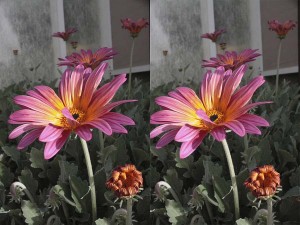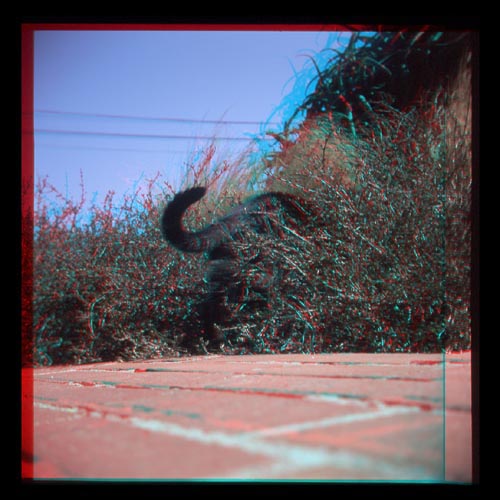Get out your 3D glasses! Part of this Garden Bloggers Bloom Day posting comes to you in glorious 3D, inspired by the news that 3D television was the big news at the recent Las Vegas Consumer Electronics Show, and by past, current and future 3D movies (Avatar, The Creature from the Black Lagoon, Alice in Wonderland).
This is one of my clones of Arctotis acaulis, which is just coming into bloom.
To view the 3D effect you’ll need a pair of glasses or a viewer that has a red lens over the left eye and a cyan (green works too) lens over the right. This image, what’s called an anaglyph, is pretty low-tech, more Black Lagoon than Avatar, but it works. I won’t detail all the steps for making it, but there are lots of explanations out on the web for how to do it in Photoshop. [ Here’s one. ] You can also use a good photo editor like Photoshop Elements that will let you adjust the individual color channels of the image.
You don’t need a proper 3D camera to photograph slow-moving subjects like flowers, but you’ll need two separate images, one for the left eye, and another for the right. Just take two images of the same subject, moving slightly left-to-right before you click the second image. If you have a camera with manual controls, you’ll get the best results if you focus and set the exposure manually.
This is the image pair I started with for the anaglyph above. You might even be able to view this raw pair in 3D. Some people are able to practice what’s called “free-viewing,” where the left eye focuses on the left image and the right eye on the right-hand one. You’ll eventually see three images, and the central one will suddenly pop into 3D.
This last pair shows the next-to-last step big step, before you layer the cyan image over the red one to create the final 3D image.
The rest of this post returns to stodgy old 2D. Sorry.
Winter is the big bloom season for many of the native plants, as well as for many plants adapted to Southern California’s mediterranean climate. Here are many of the plants flowering right now.
Here’s the agave I featured prominently in last month’s posting. It’s nearing its half-way point on the spike.
First blooms of the season on Verbena lilacina.
First blooms of the season on Nuttall’s milkvetch, Astragalus nuttallii.
The very first, brave bloom on another Arctotis acaulis clone, ‘Big Magenta.’
First flowering on another plant, likely Crassula multicava. The bed where this plant is will soon be covered with a dense mist of flowers for several months.
Another flowering crassula, Crassula ovata, your basic jade plant.
Black sage, Salvia mellifera, coming into bloom.
Santa Cruz Island buckwheat, Eriogonum arborescens, still blooming–the Energizer Bunny of buckwheats.
…some weird bromeliad. I have a likely name somewhere, but not stored in my brain’s RAM right now…
I was taking some pictures of this desert mallow, Sphaeralcea ambigua, but was more captivated by the interesting damage patterns created by a leaf-mining insect.
And last but not least: What I’m certain will be the last paperwhite narcissus of the season. I keep thinking that, but another clump pushes up through the earth and starts to flower. I’m not complaining.
As usual, my thanks Carol of May Dreams Gardens for hosting Garden Bloggers’ Bloom Day! Check out what’s in bloom in other gardens around the world [ here ].
If you haven’t had enough of the 3D photos, check out a much earlier 3D garden blog post [ here ].
Now enough of this 2D indoors nonsense. Open the door, and go outside and enjoy your garden in the grand glorious 3D it comes in naturally.

















